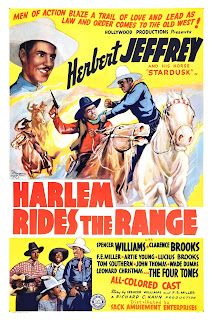YouTube viewing
I really wanted to write about a black cowboy movie but thought I’d have to settle for one from the 70s or 80s. Then I came across this discovery: Herb Jeffries (AKA Herbert Jeffrey) was a singing cowboy from the 30s who starred in westerns with all-black casts.
He was very light-skinned (his mom was white) but identified as black. He started out as a singer in Detroit and moved to Chicago. In 1931 he joined Earl Hines’ band for a few years and then moved to LA in 1934. In time he became part of Duke Ellington’s band and lowered his vocal range to sound more like Bing Crosby.
While touring in the South with Hines, Jeffries experienced racism for the first time; the band could only play in tobacco warehouses and black-only theaters. When he saw black kids watching westerns, he decided they should have a black cowboy hero of their own.
He hooked up with producer Jed Buell, raised some money and wrote songs for the film. Jeffries had learned about horse riding on his grandfather’s farm, so he cast himself in the lead and used makeup to darken his skin.
Harlem on the Prairie was shot in five days in 1937 and though the critical reaction was mixed, it got a write-up in Time. “The Bronze Buckaroo” went on to make three more westerns, including the one I watched, Harlem Rides the Range, from 1939. I’m sorry to say it’s not very good; the acting is amateurish, the editing uninspired and there are only two songs in the hour-long movie.
That said, Jeffries was a good singer and the fact that his movies got made at all is an accomplishment in itself worth noting. He appeared in other non-western movies and television later in life, including an episode of The Virginian. A documentary short, A Colored Life, was made about him in 2008.













